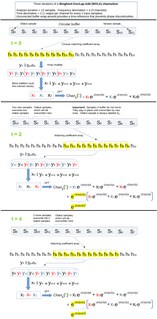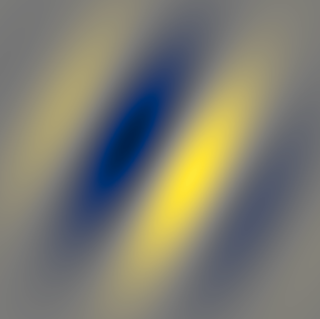Related Research Articles

In numerical analysis and functional analysis, a discrete wavelet transform (DWT) is any wavelet transform for which the wavelets are discretely sampled. As with other wavelet transforms, a key advantage it has over Fourier transforms is temporal resolution: it captures both frequency and location information.
Stransform as a time–frequency distribution was developed in 1994 for analyzing geophysics data. In this way, the S transform is a generalization of the short-time Fourier transform (STFT), extending the continuous wavelet transform and overcoming some of its disadvantages. For one, modulation sinusoids are fixed with respect to the time axis; this localizes the scalable Gaussian window dilations and translations in S transform. Moreover, the S transform doesn't have a cross-term problem and yields a better signal clarity than Gabor transform. However, the S transform has its own disadvantages: the clarity is worse than Wigner distribution function and Cohen's class distribution function.

In signal processing, a filter bank is an array of band-pass filters that separates the input signal into multiple components, each one carrying a single frequency sub-band of the original signal. One application of a filter bank is a graphic equalizer, which can attenuate the components differently and recombine them into a modified version of the original signal. The process of decomposition performed by the filter bank is called analysis ; the output of analysis is referred to as a subband signal with as many subbands as there are filters in the filter bank. The reconstruction process is called synthesis, meaning reconstitution of a complete signal resulting from the filtering process.

In image processing, a Gabor filter, named after Dennis Gabor, is a linear filter used for texture analysis, which means that it basically analyzes whether there are any specific frequency content in the image in specific directions in a localized region around the point or region of analysis. Frequency and orientation representations of Gabor filters are claimed by many contemporary vision scientists to be similar to those of the human visual system. They have been found to be particularly appropriate for texture representation and discrimination. In the spatial domain, a 2D Gabor filter is a Gaussian kernel function modulated by a sinusoidal plane wave.
Originally known as Optimal Subband Tree Structuring (SB-TS) also called Wavelet Packet Decomposition (WPD) (sometimes known as just Wavelet Packets or Subband Tree) is a wavelet transform where the discrete-time (sampled) signal is passed through more filters than the discrete wavelet transform (DWT).
The Stationary wavelet transform (SWT) is a wavelet transform algorithm designed to overcome the lack of translation-invariance of the discrete wavelet transform (DWT). Translation-invariance is achieved by removing the downsamplers and upsamplers in the DWT and upsampling the filter coefficients by a factor of in the th level of the algorithm. The SWT is an inherently redundant scheme as the output of each level of SWT contains the same number of samples as the input – so for a decomposition of N levels there is a redundancy of N in the wavelet coefficients. This algorithm is more famously known as "algorithme à trous" in French which refers to inserting zeros in the filters. It was introduced by Holschneider et al.
The linear scale-space representation of an N-dimensional continuous signal,
In image processing and computer vision, a scale space framework can be used to represent an image as a family of gradually smoothed images. This framework is very general and a variety of scale space representations exist. A typical approach for choosing a particular type of scale space representation is to establish a set of scale-space axioms, describing basic properties of the desired scale-space representation and often chosen so as to make the representation useful in practical applications. Once established, the axioms narrow the possible scale-space representations to a smaller class, typically with only a few free parameters.
In functional analysis, compactly supported wavelets derived from Legendre polynomials are termed Legendre wavelets or spherical harmonic wavelets. Legendre functions have widespread applications in which spherical coordinate system is appropriate. As with many wavelets there is no nice analytical formula for describing these harmonic spherical wavelets. The low-pass filter associated to Legendre multiresolution analysis is a finite impulse response (FIR) filter.

Martin Vetterli is the current president of École Polytechnique Fédérale de Lausanne (EPFL) in Switzerland, succeeding Patrick Aebischer. He's a professor of engineering and was formerly the president of the National Research Council of the Swiss National Science Foundation.
Ali Naci Akansu is a Turkish-American electrical engineer and scientist. He is best known for his seminal contributions to the theory and applications of linear subspace methods including sub-band and wavelet transforms, particularly the binomial QMF, which he developed in 1990.
Contourlets form a multiresolution directional tight frame designed to efficiently approximate images made of smooth regions separated by smooth boundaries. The contourlet transform has a fast implementation based on a Laplacian pyramid decomposition followed by directional filterbanks applied on each bandpass subband.

Pyramid, or pyramid representation, is a type of multi-scale signal representation developed by the computer vision, image processing and signal processing communities, in which a signal or an image is subject to repeated smoothing and subsampling. Pyramid representation is a predecessor to scale-space representation and multiresolution analysis.
In digital signal processing, multidimensional sampling is the process of converting a function of a multidimensional variable into a discrete collection of values of the function measured on a discrete set of points. This article presents the basic result due to Petersen and Middleton on conditions for perfectly reconstructing a wavenumber-limited function from its measurements on a discrete lattice of points. This result, also known as the Petersen–Middleton theorem, is a generalization of the Nyquist–Shannon sampling theorem for sampling one-dimensional band-limited functions to higher-dimensional Euclidean spaces.
In the mathematical fields of numerical analysis and approximation theory, box splines are piecewise polynomial functions of several variables. Box splines are considered as a multivariate generalization of basis splines (B-splines) and are generally used for multivariate approximation/interpolation. Geometrically, a box spline is the shadow (X-ray) of a hypercube projected down to a lower-dimensional space. Box splines and simplex splines are well studied special cases of polyhedral splines which are defined as shadows of general polytopes.
In signal processing, multidimensional signal processing covers all signal processing done using multidimensional signals and systems. While multidimensional signal processing is a subset of signal processing, it is unique in the sense that it deals specifically with data that can only be adequately detailed using more than one dimension. In m-D digital signal processing, useful data is sampled in more than one dimension. Examples of this are image processing and multi-sensor radar detection. Both of these examples use multiple sensors to sample signals and form images based on the manipulation of these multiple signals. Processing in multi-dimension (m-D) requires more complex algorithms, compared to the 1-D case, to handle calculations such as the Fast Fourier Transform due to more degrees of freedom. In some cases, m-D signals and systems can be simplified into single dimension signal processing methods, if the considered systems are separable.
In signal processing it is useful to simultaneously analyze the space and frequency characteristics of a signal. While the Fourier transform gives the frequency information of the signal, it is not localized. This means that we cannot determine which part of a signal produced a particular frequency. It is possible to use a short time Fourier transform for this purpose, however the short time Fourier transform limits the basis functions to be sinusoidal. To provide a more flexible space-frequency signal decomposition several filters have been proposed. The Log-Gabor filter is one such filter that is an improvement upon the original Gabor filter. The advantage of this filter over the many alternatives is that it better fits the statistics of natural images compared with Gabor filters and other wavelet filters.
This article provides a short survey of the concepts, principles and applications of Multirate Filter Banks and Multidimensional Directional Filter Banks.
Wavelets are often used to analyse piece-wise smooth signals. Wavelet coefficients can efficiently represent a signal which has led to data compression algorithms using wavelets. Wavelet analysis is extended for multidimensional signal processing as well. This article introduces a few methods for wavelet synthesis and analysis for multidimensional signals. There also occur challenges such as directivity in multidimensional case.
Palghat P. Vaidyanathan is the Kiyo and Eiko Tomiyasu Professor of Electrical Engineering at the California Institute of Technology, Pasadena, California, USA, where he teaches and leads research in the area of signal processing, especially digital signal processing (DSP), and its applications. He has authored four books, and authored or coauthored close to five hundred papers in various IEEE journals and conferences. Prof. Vaidyanathan received his B.Tech and M. Tech degrees from the Institute of Radiophysics and Electronics, University of Kolkata, and a Ph.D degree in Electrical Engineering from University of California Santa Barbara in 1982.
References
- ↑ J. Kovacevic and M. Vetterli, "Nonseparable multidimensional perfect reconstruction filter banks and wavelet bases for Rn," IEEE Trans. Inf. Theory, vol. 38, no. 2, pp. 533–555, Mar. 1992.
- ↑ J. Kovacevic and M. Vetterli, "Nonseparable two- and three-dimensional wavelets," IEEE Transactions on Signal Processing, vol. 43, no. 5, pp. 1269–1273, May 1995.
- ↑ G. Uytterhoeven and A. Bultheel, "The Red-Black Wavelet Transform," in IEEE Signal Processing Symposium, pp. 191–194, 1998.
- ↑ M. N. Do and M. Vetterli, "The contourlet transform: an efficient directional multiresolution image representation," IEEE Transactions on Image Processing, vol. 14, no. 12, pp. 2091–2106, Dec. 2005.
- ↑ G. Kutyniok and D. Labate, "Shearlets: Multiscale Analysis for Multivariate Data," 2012.
- ↑ V. Velisavljevic, B. Beferull-Lozano, M. Vetterli and P. L. Dragotti, "Directionlets: anisotropic multi-directional representation with separable filtering," IEEE Trans. on Image Proc., Jul. 2006.
- ↑ E. P. Simoncelli and W. T. Freeman, "The Steerable Pyramid: A Flexible Architecture for Multi-Scale Derivative Computation," in IEEE Second Int'l Conf on Image Processing. Oct. 1995.
- ↑ D. Barina, M. Kula and P. Zemcik, "Parallel wavelet schemes for images," J Real-Time Image Proc, vol. 16, no. 5, pp. 1365–1381, Oct. 2019.
| This signal processing-related article is a stub. You can help Wikipedia by expanding it. |